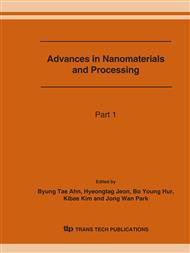p.85
p.89
p.93
p.97
p.101
p.105
p.109
p.113
p.119
Effect of Buffer Thickness on the Formation of ZnO Nanorods Grown by MOCVD
Abstract:
ZnO semiconductor has a wide band gap of 3.37 eV and a large exciton binding energy of 60 meV, and displays excellent sensing and optical properties. In particular, ZnO based 1D nanowires and nanorods have received intensive attention because of their potential applications in various fields. We grew ZnO buffer layers prior to the growth of ZnO nanorods for the fabrication of the vertically well-aligned ZnO nanorods without any catalysts. The ZnO nanorods were grown on Si (111) substrates by vertical MOCVD. The ZnO buffer layers were grown with various thicknesses at 400 °C and their effect on the formation of ZnO nanorods at 300 °C was evaluated by FESEM, XRD, and PL. The synthesized ZnO nanorods on the ZnO film show a high quality, a large-scale uniformity, and a vertical alignment along the [0001]ZnO compared to those on the Si substrates showing the randomly inclined ZnO nanorods. For sample using ZnO buffer layer, 1D ZnO nanorods with diameters of 150-200 nm were successively fabricated at very low growth temperature, while for sample without ZnO buffer the ZnO films with rough surface were grown.
Info:
Periodical:
Pages:
101-104
Citation:
Online since:
June 2007
Keywords:
Price:
Сopyright:
© 2007 Trans Tech Publications Ltd. All Rights Reserved
Share:
Citation:


